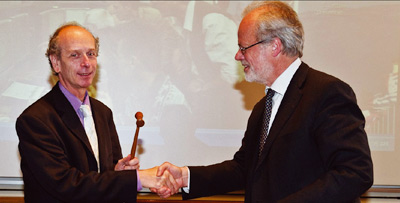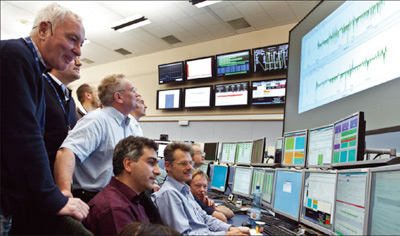
At its 153rd session on 18 December, the CERN Council heard that the LHC had ended its first full period of operation two days earlier, following collisions at a total energy of 2.36 TeV – a world record. The LHC circulated its first beams of 2009 on 20 November, ushering in a remarkably rapid beam-commissioning phase (The LHC is back: a remarkable four weeks). The first collisions were recorded on 23 November, and the world-record beam energy was established on 30 November. Following these milestones, a systematic phase of commissioning led to a period in which the six LHC experiments recorded more than a million collision events, which were distributed for analysis around the world on the LHC Computing Grid.
At the end of this first period of running, the LHC went into standby mode for a short technical stop to allow preparations for higher energy running after a restart scheduled for February. In November teams had commissioned and tested the magnet powering up to 2 kA, which corresponds to a beam energy of 1.18 TeV. To run at higher energies requires higher currents, placing more exacting demands on the new machine protection systems, which need to be readied for the task. Commissioning work for higher energies has been under way throughout January, together with necessary adaptations to the hardware and software of the protections systems that have come to light during the 2009 run.

“Council is extremely pleased and impressed by the way the LHC, the experiments and the Computing Grid have operated this year,” said Council president Torsten Åkesson. “The laboratory set itself an ambitious but realistic programme at its February [2009] planning meeting. The fact that all the objectives set back then have been achieved is a ringing endorsement of the step-by-step approach adopted by CERN management.”
Other Council business included the question of geographic enlargement of CERN. Council heard from a working group established in 2008 to examine this question, and accepted a series of guiding principles concerning such an enlargement, with a possible associate status involving balanced benefits and obligations being developed. In parallel, CERN has received five applications for membership over the past 12 months. Council decided to establish a working group to undertake the tasks of technical verification and fact-finding relating to these applications.
At the end of the meeting, Åkesson handed over the Council’s presidency to Michel Spiro, director of the National Institute for Nuclear Physics and Particle Physics (IN2P3) at the Department of Nuclear and Particle Physics and of the National Centre for Scientific Research (CNRS) in France. “I am greatly honoured to have been elected president of the CERN Council,” said Spiro. “I will be the Council’s 20th president, and it is with humility that I take up the mantle of my illustrious predecessors, not least Professor Åkesson, who has made significant progress with the organization over the term of his mandate. With the first results from the LHC eagerly anticipated, the period ahead promises to be a golden era: it is these results that will shape the future of particle physics and of CERN.”








